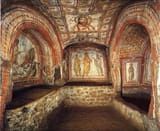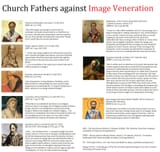
IMG_4655
md5: e7c62118fa51d172c98ee24bdebeb865
🔍
>The church fathers support Cath-
Oops! Looks like Protestants can quote mine the fathers too, in fact the early church demolishes core Catholic doctrines. Huh.
>>17766787 (OP)All I see are jews
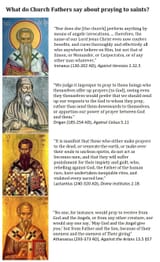
IMG_4656
md5: 4a49625662d250ed9777c844835b94c4
🔍
>>17766790You should talk to a psychiatrist about that.
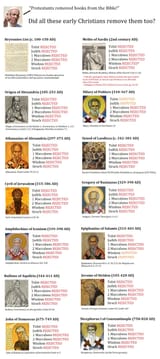
IMG_4657
md5: 184c93abd71031ee764c3a73a92eaae4
🔍

Graul
md5: 3410a7d9b3c0ae8ec66a0a0afa8ef39d
🔍
The Church protected the Jews:
"Then the Jews cried out, and the secret of Jehovah (Yahweh) began to cry out with them: The papal vicars of Jesus, fiercely burning against the heretics, railed against the oppression of the Jews and protectively held their hands over the chosen ones."
(Pg 10)
Christianity bastardized nature:
"The holy became vile: the woman—nurturer of life—became the "vessel of sin." Her radiant beauty became the absolute evil, became "sexual." The divine law of life, which unites the "sexes" for the birth of new life, and visions of tormented senses in the despised body became temptations of the devil."
(Pg 13)
Christian superstition stunted medicine
"The bearers of Christian wisdom, according to the testimony of the New Testament, say that diseases are demonic possessions. A healing without the help of Jehovah or pure exorcism must be a demonic enchantment beforehand, for only then could the power over the disease, without Christian salvation and grace, be explained."
(Pg 17)
The Church massacred Europeans via the witch trials, and protected the Jews.
"With the full authority of the Church, it unleashed all the destructive propaganda of total Christianity, proudly proclaiming that in Germany a secret kingdom of Lucifer—the Light-bringer, the devil—had risen to the detriment of the representatives of Jehovah (Yahweh).
And the living became the most wretched under heaven: millions of Nordic people—men, women, and children—were murdered. The groaning of the crackling pyres, the anguished cries of Christianity, rose from the flames. It is only recently known that a Jewess, as a witch, was burned—the executioner had erred."
(Pg 22)
Source: Werner Graul Hexen Ketzer Heilige (1937)
>>17766825Schizophrenic rants about Jews need to be banned.

IMG_0502
md5: 0e3a4aaf27c2936dc1b0ec210855cf2e
🔍
>>17766829Aren’t you guys responsible for like 50% of the posts on this site
>>17766787 (OP)did you "oops!" shit yourself again?
>>17766836>/pol/You should go back there, you'll find lots of mentally ill people like you
>>17766787 (OP)>>17766837reminded anon to analyze the "consistency" of his world again.
>>17766865
>>17766841there's always more room for jell-o
>>17766430
Uhhh Protestant bros? I thoughts the fathers were on our side!?
>For only the harder portions of his holy remains were left, which were conveyed to Antioch and wrapped in linen, as an inestimable treasure left to the holy Church by the grace which was in the martyr
Marytrdom of St Ignatius of Antioch ch 6 (50-117 ad)
>Accordingly, we afterwards took up his bones, as being more precious than the most exquisite jewels, and more purified than gold, and deposited them in a fitting place, whither, being gathered together, as opportunity is allowed us, with joy and rejoicing, the Lord shall grant us to celebrate the anniversary of his martyrdom, both in memory of those who have already finished their course, and for the exercising and preparation of those yet to walk in their steps
Polycarp Martyrdom of Polycarp Ch 18 (69-155 ad)
>The brazen serpent and the golden cherubim were not violations of the Second Commandment. Their meaning. Likewise, when forbidding the similitude to be made of all things which are in heaven, and in earth, and in the waters, He declared also the reasons, as being prohibitory of all material exhibition of a latent idolatry. For He adds: "Thou shalt not bow down to them, nor serve them." The form, however, of the brazen serpent which the Lord afterwards commanded Moses to make, afforded no pretext for idolatry, but was meant for the cure of those who were plagued with the fiery serpents? I say nothing of what was figured by this cure. Thus, too, the golden Cherubim and Seraphim were purely an ornament in the figured fashion of the ark; adapted to ornamentation for reasons totally remote from all condition of idolatry, on account of which the making a likeness is prohibited; and they are evidently not at variance with this law of prohibition, because they are not found in that form of similitude, in reference to which the prohibition is given.
Tertullian Against Marcion Book 2 ch 22 (160-240 ad)
UHHH PROT BROS!?
>In the meanwhile a spirited body of senators of those who are engaged in the public transport service, seeing what had happened, for they were near the sea, prepared a boat, and suddenly seizing upon the sacred relics, they placed them in it, and scaling the Pharos from behind, by a quarter which has the name of Leucado, they came to the church of the most blessed mother of God, and Ever-Virgin Mary, which, as we began to say, he had constructed in the western quarter, in a suburb, for a cemetery of the martyrs
Peter of Alexandria Genuine Acts of Peter (260-311ad)
>They say that this statue is an image of Jesus. It has remained to our day, so that we ourselves also saw it when we were staying in the city. Nor is it strange that those of the Gentiles who, of old, were benefited by our Saviour, should have done such things, since we have learned also that the likenesses of his apostles Paul and Peter, and of Christ himself, are preserved in paintings, the ancients being accustomed, as it is likely, according to a habit of the Gentiles, to pay this kind of honor indiscriminately to those regarded by them as deliverers.
>Eusebius of Caesarea Church History book 7 (295-340ad)
>But each of those who received the sheepskin of the blessed Anthony and the garment worn by him guards it as a precious treasure. For even to look on them is as it were to behold Anthony; and he who is clothed in them seems with joy to bear his admonitions.
Athanasius Life of St Anthony par 92 (296-373 ad)
>If I am able to find any relics of martyrs, I pray that I may take part in your earnest endeavour.
Basil Letter 49 (329-379 ad)
>If you send the relics of the martyrs home you will do well; as you write that the persecution there is, even now, causing martyrs to the Lord.
Basil Letter 155 (329-379 ad)
PROT BROS I... I DON'T FEEL SO GOOD!
>he took up the relics with all becoming reverence, and has aided the brethren in their preservation. These relics do you receive with a joy equivalent to the distress with which their custodians have parted with them and sent them to you
Basil Letter 197 par 2 (329-379 ad)
>I acknowledge also the holy apostles, prophets, and martyrs; and I invoke them to supplication to God, that through them, that is, through their mediation, the merciful God may be propitious to me, and that a ransom may be made and given me for my sins. Wherefore also I honour and kiss the features of their images, inasmuch as they have been handed down from the holy apostles, and are not forbidden, but are in all our churches.
>Basil Letter 360 (329-379 ad)
>She hurried to the martyrs' shrines unnoticed. Such visits gave her pleasure, and the more so because she was never recognized.
Jerome Letter 24 par 4 (347-420 ad)
>It is true that a festival such as the birthday of Saint Peter should be seasoned with more gladness than usual; still our merriment must not forget the limit set by Scripture, and we must not stray too far from the boundary of our wrestling-ground.
Jerome Letter 31 par 2 (347-420 ad)
>Everywhere we venerate the tombs of the martyrs; we apply their holy ashes to our eyes; we even touch them, if we may, with our lips.
Jerome Letter 46 par 8 (347-420 ad)
>We shall see the fountain in which the eunuch was immersed by Philip. We shall make a pilgrimage to Samaria, and side by side venerate the ashes of John the Baptist, of Elisha, and of Obadiah.
Jerome Letter 46 par 13 (347-420 ad)
>Are we, therefore guilty of sacrilege when we enter the basilicas of the Apostles? Was the Emperor Constantius I. guilty of sacrilege when he transferred the sacred relics of Andrew, Luke, and Timothy to Constantinople?
Jerome against the Vigilantius par 5 (347-420 ad)
NOOOOOOOOOOOOOOOOOO AHHHHH PROT BROS AHHHHHHHHHHHHHHHHHHHHHHH
>For not the bodies only, but the very sepulchres of the saints have been filled with spiritual grace. For if in the case of Elisha this happened, and a corpse when it touched the sepulchre, burst the bands of death and returned to life again, much rather now, when grace is more abundant, when the energy of the spirit is greater, is it possible that one touching a sepulchre, with faith, should win great power; thence on this account God allowed us the remains of the saints, wishing to lead by them us to the same emulation, and to afford us a kind of haven, and a secure consolation for the evils which are ever overtaking us.
John Chrysostom Homily on St Ignatius par 5 (347-407 ad)
>Veneration of the Cross. Then a chair is placed for the bishop in Golgotha behind the Cross, which is now standing; the bishop duly takes his seat in the chair, and a table covered with a linen cloth is placed before him; the deacons stand round the table, and a silver-gilt casket is brought in which is the holy wood of the Cross. The casket is opened and (the wood) is taken out, and both the wood of the Cross and the title are placed upon the table.
Egeria Discription of the Liturgical Year in Jerusalem XXXVII (348-418 ad)
>In this district there lived for a long while monks of the most perfect life and holiness, who were suddenly destroyed by an incursion of Saracen robbers: whose bodies we knew were seized upon with the greatest veneration both by the Bishops of the neighbourhood and by the whole populace of Arabia, and deposited among the relics of the martyrs, so that swarms of people from two towns met, and made terrible war upon each other, and in their struggle actually came to blows for the possession of the holy spoil, while they strove among themselves with pious zeal as to which of them had the better claim to bury them and keep their relics
John Cassian Conference 6 ch 1 (360-435 ad)
NOOOOO NOT AUGUSTINE HE WAS A CALVINIST!!! AHHHHHHHHH
>how much stronger is their claim on you, who reside in the same country in this earth in which these ladies, for the love of Christ, renounced the distinctions of this world I also ask you to condescend to receive with the same love with which I have offered it my official salutation, and to remember me in your prayers. These ladies carry with them relics of the most blessed and glorious martyr Stephen: your Holiness knows how to give due honour to these, as we have done.
Augustine Letter 212 (354-430 ad)
>But that the Holy Spirit is not a creature is made quite plain by that passage above all others, where we are commanded not to serve the creature, but the Creator; not in the sense in which we are commanded to "serve" one another by love, which is in Greek douleuein, but in that in which God alone is served, which is in Greek latreuein. From whence they are called idolaters who tender that service to images which is due to God. For it is this service concerning which it is said, "Thou shalt worship the Lord thy God, and Him only shalt thou serve." For this is found also more distinctly in the Greek Scriptures, which have latreuseis. Now if we are forbidden to serve the creature with such a service, seeing that it is written, the creature more than the Creator), then assuredly the Holy Spirit is not a creature, to whom such a service is paid by all the saints; as says the apostle, "For we are the circumcision, which serve the Spirit of God," which is in the Greek latreuontes. For even most Latin copies also have it thus,
Augustine on the Holy Trinity Book 1 ch 6.13 (354-430 ad)
NOOOOOOO HOW AM I SUPPOSSED TO WIN INTERNET DEBATES AGAINST THOSE TRADCATHS NOW!? AHHHHHHHHHHHHHH
>What is properly divine worship, which the Greeks call latria, and for which there is no word in Latin, both in doctrine and in practice, we give only to God. To this worship belongs the offering of sacrifices; as we see in the word idolatry, which means the giving of this worship to idols. Accordingly we never offer, or require any one to offer, sacrifice to a martyr, or to a holy soul, or to any angel. Any one falling into this error is instructed by doctrine, either in the way of correction or of caution.
Augustine Reply to Faustus the Manichean Book 20 par 21 (354-430 ad)
>For even now miracles are wrought in the name of Christ, whether by His sacraments or by the prayers or relics of His saints; but they are not so brilliant and conspicuous as to cause them to be published with such glory as accompanied the former miracles.
Augustine of Hippo City of God Book 22 ch 8 (354-430 ad)
HELLO PROTNESS MY OLD FRIEND
>Theodosius, the humble Christian, to the holy and Ecumenical Synod: I confess and I agree to (suntiqemai) and I receive and I salute and I venerate in the first place the spotless image of our Lord Jesus Christ, our true God, and the holy image of her who bore him without seed, the holy Mother of God, and her help and protection and intercessions each day and night as a sinner to my aid I call for, since she has confidence with Christ our God, as he was born of her. Likewise also I receive and venerate the images of the holy and most laudable Apostles, prophets, and martyrs and the fathers and cultivators of the desert. Not indeed as gods (God forbid!) do I ask all these with my whole heart to pray for me to God, that he may grant me through their intercessions to find mercy at his hands at the day of judgment, for in this I am but showing forth more clearly the affection and love of my soul which I have borne them from the first. Likewise also I venerate and honour and salute the reliques of the Saints as of those who fought for Christ and who have received grace from him for the healing of diseases and the curing of sicknesses and the casting out of devils, as the Christian Church has received from the holy Apostles and Fathers even down to us to-day.
Council of Ephesus Extracts from session 1 (431 ad)
>If for this instruction for which images were anciently made you wish to have them in the church, I permit them by all means both to be made and to be had. And explain to them that it was not the sight itself of the story which the picture was hanging to attest that displeased thee, but the adoration which had been improperly paid to the pictures.
Gregory the Great Letters Book 11 letter 13 (540-604 ad)
I'VE COME TO TALK WITH YOU AGAIN
>Furthermore we notify to you that it has come to our ears that your Fraternity, seeing certain adorers of images, broke and threw down these same images in Churches. And we commend you indeed for your zeal against anything made with hands being an object of adoration; but we signify to you that you ought not to have broken these images. For pictorial representation is made use of in Churches for this reason; that such as are ignorant of letters may at least read by looking at the walls what they cannot read in books. Your Fraternity therefore should have both preserved the images and prohibited the people from adoration of them, to the end that both those who are ignorant of letters might have wherewith to gather a knowledge of the history, and that the people might by no means sin by adoration of a pictorial representation
Gregory the Great Letters Book 9 letter 105 (540-604 ad)
>The Serenity of your Piety, conspicuous for religious zeal and love of holiness, has charged me with your commands to send to you the head of Saint Paul, or some other part of his body, for the church which is being built in honour of the same Saint Paul in the palace. And, being desirous of receiving commands from you, by exhibiting the most ready obedience to which I might the more provoke your favour towards me, I am all the more distressed that I neither can nor dare do what you enjoin. For the bodies of the apostles Saint Peter and Saint Paul glitter with so great miracles and terrors in their churches that one cannot even go to pray there without great fear. In short, when my predecessor, of blessed memory, was desirous of changing the silver which was over the most sacred body of the blessed apostle Peter, though at a distance of almost fifteen feet from the same body, a sign of no small dreadfulness appeared to him.
Gregory the Great Letters Book 4 letter 30 (540-604 ad)
Prot bros... I think we lost...
>From the Life of the Abbot Daniel, on Eulogius the Quarryman. Then he went away dejected, and threw himself before an image of Our Lady, and crying out, he said: "Lord, enable me to pay what I promised this man."
John of Damascus Apologia Against those who Decry Holy Images (676-749 ad)
>St Basil says, "Honouring the image leads to the prototype." If you raise churches to the saints of God, raise also their trophies.
John of Damascus Apologia Against those who Decry Holy Images (676-749 ad)
>A tradition has come down to us that Angaros, King of Edessa, was drawn vehemently to divine love by hearing of our Lord,* and that he sent envoys to ask for His likeness. If this were refused, they were ordered to have a likeness painted. Then He, who is all-knowing and all-powerful, is said to have taken a strip of cloth, and pressing it to His face, to have left His likeness upon the cloth, which it retains to this day.
John of Damascus Apologia Against those who Decry Holy Images (676-749 ad)
NOOOO THEY TOLD ME THAT QUOTE FROM EPIPHANIUS WAS LEGIT NOOOOOOOOOOOOOO
>If you say to this that blessed Epiphanius clearly rejected our use of images, you must know that the work in question is spurious and written by some one else in the name of Epiphanius, as often happens. A father does not fight his own children. All have become participators in the one Spirit. The Church is a witness of this in adorning images, until some men rose up against her and disturbed the peace of Christ's fold, putting poisoned food before the people of God.
John of Damascus Apologia Against those who Decry Holy Images (676-749 ad)
>Listen to what I am going to say as a proof that images are no new invention. It is an ancient practice well known to the best and foremost of the fathers. Elladios, the disciple of blessed Basil and his successor, says in his Life of Basil that the holy man was standing by the image of Our Lady, on which was painted also the likeness of Mercurius, the renowned martyr. He was standing by it asking for the removal of the impious apostate Julian, and he received this revelation from the statue. He saw the martyr vanish for a time, and then reappear, holding a bloody spear.
John of Damascus Apologia Against those who Decry Holy Images (676-749 ad)
>We, therefore, following the royal pathway and the divinely inspired authority of our Holy Fathers and the traditions of the Catholic Church (for, as we all knoweth Holy Spirit indwells her), define with all certitude and accuracy that just as the figure of the precious and life-giving Cross, so also the venerable and holy images, as well in painting and mosaic as of other fit materials, should be set forth in the holy churches of God, and on the sacred vessels and on the vestments and on hangings and in pictures both in houses and by the wayside, to wit, the figure of our Lord God and Saviour Jesus Christ, of our spotless Lady, the Mother of God, of the honourable Angels, of all Saints and of all pious people. For by so much more frequently as they are seen in artistic representation, by so much more readily are men lifted up to the memory of their prototypes, and to a longing after them; and to these should be given due salutation and honorable reverence not indeed that true worship of faith which pertains alone to the divine nature; but to these, as to the figure of the precious and life-giving Cross and to the Book of the Gospels and to the other holy objects, incense and lights may be offered according to ancient pious custom. For the honor which is paid to the image passes on to that which the image represents, and he who reveres the image reveres in it the subject represented...
2nd Council of Nicaea During the time of Stephen II [787-788 AD]
Well prot bros, looks like we should become Catholic. The true faith always triumphs. Maranatha!
Being reasonable and kind to each other is more important than what religions we follow, or our rituals.
Let us not fight our ancestors' wars.
Let us be free of superstition and malice.
Holy smokes, this popecuck had a full blown meltdown.
>>17767345Pretentious and gay
>>17767363Great non-argument.
>>17766787 (OP)>>17766791Honestly this has given me a lot of food for thought. I'll make sure to bring it up with my priest and ask about it.
>>17766905>>17766934>All those quotes either don't contradict Protestant doctrines, or are from the Middle Ageswow, good job
>>17766931>>17766931>(676-749)If anything this supports the prots
>my jew worship is more valid than your jew worship
I don't fucking care. You abrahamics should all throw yourself into a ditch
>>17768370And none of the quotes in the OP contradict Catholicism or Orthodoxy.
>>17766791>origen>church father
>>17768651You didn't read it did you
>>17768651Image veneration, prayers to the saints, and the canon are all dogmatized aspects of the faith
>>17766905>Marytrdom of St Ignatius of Antioch ch 6 (50-117 ad)That date is when Ignatius lived, not when the martyrdom narrative was written, which was later. In any case, your quote doesn't meaning praying to the relics.
>Martyrdom of Polycarp Ch 18 (69-155 ad)Again, the martyrdom account is later and only mentions remembering Polycarp at his grave or sepulchre, no mention of praying to a relic.
>Tertullian Against Marcion Book 2 ch 22 (160-240 ad)Again, nothing against the Protestant position. In fact the example of the brazen serpent supports Protestantism, since it was considered an idol once people began worshipping it (2 Kings 18:4)
>Peter of Alexandria Genuine Acts of Peter (260-311ad)The source of that translation points out that it's a medieval adaptation of an older work and is full of anachronisms about the cult of the saints and popes: https://en.m.wikisource.org/wiki/Ante-Nicene_Fathers/Volume_VI/Peter_of_Alexandria/The_Genuine_Acts_of_Peter
>Eusebius of Caesarea Church History book 7 (295-340ad)Eusebius says here that making those statues came from pagan practice, and they were public decorations in any case, not icons being venerated. Eusebius was famously against venerating images.
>Athanasius Life of St Anthony par 92 (296-373 ad)This is just admiring an artefact, nothing about praying to it. Same goes for Basil.
The rest of your stuff is getting into the 5th century AD, exactly when Protestants say the rot of the cult of saints was taking hold.
>>17768713>Again, the martyrdom account is later and only mentions remembering Polycarp at his grave or sepulchre, no mention of praying to a relic.False. The martyrdom of Polycarp is widely regarded as very early, no later than 200 CE, about 45 years after his actual martyrdom, but likely much earlier, in the 160s or 150s, and there's still a good argument to be made for it being an eyewitness testimony. It's the earliest reference we have to the veneration of relics. In these types of discussion, Protestants overlook the fact that the veneration of relics was indeed a widespread, very common, perhaps THE way people practiced Christianity aside from assembly (church) gatherings. There are hundreds of years of quotes, from the 2nd century on, supporting relics in the fathers and references to them, as the Catholic poster above already demonstrated, are abundant in them. You can find references to relics in Augustine, in Jerome, in John Chrysostom.
>Eusebius says here that making those statues came from pagan practice, and they were public decorations in any case, not icons being venerated. Eusebius is speaking positively about the custom, he never condemns it and in fact he seems to assent to the tradition that it was a genuinely antique image of Christ.
>Eusebius was famously against venerating images.The Letter to Constantina has long been known to be an iconoclast forgery.
>This is just admiring an artefact,... Same goes for Basil.It's called a relic. Learn what a relic is. St. Athanasius of Alexandria is yet another testimony to the universal veneration of relics by the early Church.
>nothing about praying to it. Nobody prays to relics, images, or sacramentals. Catholics do not do this. Orthodox do not do this.
You also failed to address the other quotes above, many from reputable Church Fathers that many Protestants also respect, which do mention either images, acts of veneration, or both.
>>17768713Wrecked him
>>17769356Weak, avoiding his arguments
>>17769356Ok, so for your first reply you don't quote or cite a single source.
As for your second, all you say is "Eusebius said there was a statue of Jesus". Ok? I didn't dispute that.
Third, you need to provide proof andnrebut the scholars who argue for it being geniune. " It's long been known" is not an argument, or I could just say the whole New Testament is forged, without providing an argument.
Fourth, you just use the word relic, which is a translation. Prove from the actual context that the author supported praying to the object in the belief of gaining hominess from thr practice.
And finally
>Nobody prays to relics, images, or sacramentals. Catholics do not do this. Orthodox do not do this. Yes they absolutely 100% do this. I went to the church of the Ecumenical Patriarch of Constantinople, thinking it would be a profoundly spiritually edifying experience. Instead, what I saw was pilgrims propatrating before and praying to images and the teeth and bones of saints. There was one image of Christ which everybody ignored. If you think honouring someone's grave is the same as praying for saintlt intercession, or praying fof magical healing from a relic, you don't understand your owb theology.
>>17769369Not at all. In fact, the modern Gavin Ortlund-esque critique of image veneration is quite overstated and much of the modern Protestant critique is based in art-historian Ernst Ktizinger's revisionist model about the development of Byzantine art (https://www.youtube.com/watch?v=suDdxUC9kCc).
The archaeology also shows that Christian art was abundant in the earliest centuries, from the Roman Catacombs, to the Dura Europos church. At the very least it was present, and the Reformed fantasy of an entirely aniconic early Christianity is not well founded.
>>17769404Christian visual arts are not synonymous with image veneration.
>>17769393>Ok, so for your first reply you don't quote or cite a single source.Just about every source I've come across dates it to the late 2nd century, here's one (https://www.britannica.com/topic/Martyrdom-of-Polycarp). My specific reference was to this (https://en.wikipedia.org/wiki/Martyrdom_of_Polycarp#Date). Most of the sources I have come across date it to the 150s or 160s, so it seems that Moss's dating is a minority viewpoint, and even then it's still quite early. I fully admit to you that I am not equip to mount a defense of its date, since I'm not a scholar, but I see no reason to doubt what looks to be a consensus, even if that's technically appeal to authority.
>>17769356>As for your second, all you say is "Eusebius said there was a statue of Jesus". Ok? I didn't dispute that.Show from the context that Eusebius is negatively talking about icons. Because the context suggests he is speaking positively.
>Since I have mentioned this city I do not think it proper to omit an account which is worthy of record for posterity. For they say that the woman with an issue of blood, who, as we learn from the sacred Gospel, received from our Saviour deliverance from her affliction, came from this place, and that her house is shown in the city, and that remarkable memorials of the kindness of the Saviour to her remain there. For there stands upon an elevated stone, by the gates of her house, a brazen image of a woman kneeling, with her hands stretched out, as if she were praying. Opposite this is another upright image of a man, made of the same material, clothed decently in a double cloak, and extending his hand toward the woman. At his feet, beside the statue itself, is a certain strange plant, which climbs up to the hem of the brazen cloak, and is a remedy for all kinds of diseases. They say that this statue is an image of Jesus. It has remained to our day, so that we ourselves also saw it when we were staying in the city. Nor is it strange that those of the Gentiles who, of old, were benefited by our Saviour, should have done such things, since we have learned also that the likenesses of his apostles Paul and Peter, and of Christ himself, are preserved in paintings, the ancients being accustomed, as it is likely, according to a habit of the Gentiles, to pay this kind of honor indiscriminately to those regarded by them as deliverers.He says the account is "worthy of posterity" and that a "remarkable memorials of the kindness of the Saviour to her remain there" (i.e the statue)
>>17769393>As for your second, all you say is "Eusebius said there was a statue of Jesus". Ok? I didn't dispute that.Show from the context that Eusebius is negatively talking about icons. Because the context suggests he is speaking positively about them.
>Since I have mentioned this city I do not think it proper to omit an account which is worthy of record for posterity. For they say that the woman with an issue of blood, who, as we learn from the sacred Gospel, received from our Saviour deliverance from her affliction, came from this place, and that her house is shown in the city, and that remarkable memorials of the kindness of the Saviour to her remain there. For there stands upon an elevated stone, by the gates of her house, a brazen image of a woman kneeling, with her hands stretched out, as if she were praying. Opposite this is another upright image of a man, made of the same material, clothed decently in a double cloak, and extending his hand toward the woman. At his feet, beside the statue itself, is a certain strange plant, which climbs up to the hem of the brazen cloak, and is a remedy for all kinds of diseases. They say that this statue is an image of Jesus. It has remained to our day, so that we ourselves also saw it when we were staying in the city. Nor is it strange that those of the Gentiles who, of old, were benefited by our Saviour, should have done such things, since we have learned also that the likenesses of his apostles Paul and Peter, and of Christ himself, are preserved in paintings, the ancients being accustomed, as it is likely, according to a habit of the Gentiles, to pay this kind of honor indiscriminately to those regarded by them as deliverers.He says the account is "worthy of posterity" and that a "remarkable memorials of the kindness of the Saviour to her remain there" (i.e the statue)
>>17769444I can feel the anxiety in this guy's posts of knowing he's currently experiencing a thorough wrecking
>>17769393>Fourth, you just use the word relic, which is a translation. Prove from the actual context that the author supported praying to the object in the belief of gaining hominess from thr practice.I mean it's quite abundantly clear what they are talking about
>Everywhere we venerate the tombs of the martyrs; we apply their holy ashes to our eyes; we even touch them, if we may, with our lips.Jerome Letter 46 par 8 (347-420 ad)
>he took up the relics with all becoming reverence, and has aided the brethren in their preservation. These relics do you receive with a joy equivalent to the distress with which their custodians have parted with them and sent them to youBasil Letter 197 par 2 (329-379 ad)
>you just use the word relicOk, what do your translations say?
>>17769420I understand that. I am not arguing from the presence of Christian art alone though. However, it is an accumulating factor, at the very least the Lutherans are right. The Reformed fantasy about what the early Church was fails.
>>17769446Yes, I've read it before. Where can you point out praying to and veneration of these statues in Eusebius' account?
This seems to be a perennial issue with icon veneration supporters. You accept a theology of images themselves being holy and worthy of veneration. But when you search for evidence, you forget all that and act as if any images whatsoever necessarily require veneration.
>>17769393>Yes they absolutely 100% do this. >Proceeds to give anecdote
>>17769404>At the very least it was present, and the Reformed fantasy of an entirely aniconic early Christianity is not well founded.There is absolutely no evidence to substantiate the claim early Christians were putting up images in their churches and worshipping them, there is significant evidence that they opposed such practices once they appeared
>>17769462> But when you search for evidence, you forget all that and act as if any images whatsoever necessarily require veneration.You've not adequately addressed the Catholic posters quotes. There is an abundance of evidence for the Catholic/Orthodox position in the Fathers. But Protestants conveniently overlook these because you pick and choose how to read the Fathers. The quotes in the OP, as time and time again it's been showed when he posts these threads, that the quotes are largely taken out of context. The assumptions Protestant readers have about these heavily color their use of them.
>Where can you point out praying to and veneration of these statues in Eusebius' account?Motte:
>Eusebius's quote does not support venerationBailey:
>Eusebius's quote supports aniconismSure Eusebius doesn't mention veneration. But other Fathers do. At best you have an argument from silence from this one quote. At the very least, Eusebius was not an opponent of images. That would be my claim when using this quote.
>>17769469>Christians were putting up images in their churches and worshipping them, there is significant evidence that they opposed such practices once they appearedCool. And no modern Christian, whether Catholic or Orthodox, worship images either.
Protestants love acting like they have the high ground on this issue. They don't. Not even close.
>>17769480Quote the post where I said
>Eusebius's quote supports aniconismIn any case, you are still equivocating the doctrine of icon veneration with any Christian visual art whatsoever. What does the second Council of Nicea say about venerating images and participating in the holiness of the images?
>>17769486Is this worship?
>>17769494>Quote the post where I said "Eusebius's quote supports aniconism"When you said
>Eusebius was famously against venerating images. Eusebius was not an iconoclast. The quotes provided shows the opposite.
>>17769494>In any case, you are still equivocating the doctrine of icon veneration with any Christian visual art whatsoever. The quotes the Catholic poster above provide very ample evidence and explicit references to veneration.
>>17769509My definition of worship is obviously not the same as yours. Mine is patriotically based:
>What is properly divine worship, which the Greeks call latria, and for which there is no word in Latin, both in doctrine and in practice, we give only to God. To this worship belongs the offering of sacrifices; as we see in the word idolatry, which means the giving of this worship to idols. Accordingly we never offer, or require any one to offer, sacrifice to a martyr, or to a holy soul, or to any angel. Any one falling into this error is instructed by doctrine, either in the way of correction or of caution.Augustine Reply to Faustus the Manichean Book 20 par 21 (354-430 ad)
>>17769519*patristically
Typo, my mistake.
>>17769494>What does the second Council of Nicea say about venerating images and participating in the holiness of the images?For by so much more frequently as they are seen in artistic representation, by so much more readily are men lifted up to the memory of their prototypes, and to a longing after them; and to these should be given due salutation and honorable reverence not indeed that true worship of faith which pertains alone to the divine nature; but to these, as to the figure of the precious and life-giving Cross and to the Book of the Gospels and to the other holy objects, incense and lights may be offered according to ancient pious custom. For the honor which is paid to the image passes on to that which the image represents, and he who reveres the image reveres in it the subject represented...
The Catholic poster quotes this.
>this thread again
OP continues to make calumnies against the fathers of the Church despite being proven wrong repeatedly. May God have mercy on him.
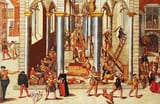
>>17769517Imagine thinking anyone is going to sift through that desperate wall of text. Nobody should be wasting their time with that, and I think it's another case of a clueless tradcath relying on the cherrypicking of his propagandists. You guys don't read the church fathers, you don't study church history, your knowledge is generally derived from memes and CatholicAnswers articles. I read the first post in the spam wall, which consists of three citations.
The first two are completely irrelevant, since they do not even mention images. The third citation, from Tertullian, further reinforces the impression the spammer is regurgitating a cherrypicked list. He never makes any claims about Christians possessing or using images in religious worship, but the entire quotation is a defense of the brazen serpent and ark of the covenant as consistent with the 2nd commandment. Is the Romanist's impression that a Protestant would disagree with this? Nor does his defense imply their worship of images is accretion, but on the contrary defends them by asserting their purposes were healing and ornamentation, and not to be objects of worship. Surely he would have fiercely refused the modern images of the Romanists and Greeks the purpose of which is to be worshipped.
>>17769519>My definition of worship is obviously not the same as yoursOK, I use God's definition. Isaiah 42:8
>I am Yahweh, that is My name; I will not give My glory to another, Nor My praise to graven images.
>>17769531>For the honor which is paid to the image passes on to that which the image representsInterestingly this is precisely what the Roman pagans said in defense of their idols and Augustine specifically rejected it.
>>17769561>Imagine thinking anyone is going to sift through that desperate wall of text.Why should anyone afford you the same charity of sifting through the wall of text in your crap memes? Just another excuse to ignore the evidence. This is what Protestants do.
>Nobody should be wasting their time with that, and I think it's another case of a clueless tradcath relying on the cherrypicking of his propagandists.You're not on a righteous crusade just because some mean tradcaths online hurt your feelings a little.
The list of quotes by the Catholic poster do have merit. I don't think it's a perfect list but many of the quotes provided are genuine and do attest to the customs of relics, veneration, and yes images. The strong Reformed claim is not supported by the evidence in the early Church. That's position is not tenable.
>OK, I use God's definition. Isaiah 42:8Begging the question.
>The Bible defines worship in the way I interpret it, because my interpretation of the Bible is correct.
>>17769558It's a pleasure watching Calvinists get a smack down.
>>17769603Cope
>>17769590>Why should anyone afford you the same charity of sifting through the wall of text in your crap memes? There's a small handful of brief quotes that are actually on topic and which are presented in a readable manner.
>You're not on a righteous crusade just because some mean tradcaths online hurt your feelings a little. Cope
>The list of quotes by the Catholic posterWhy do you keep referring to yourself in third person?
>The strong Reformed claim is not supported by the evidence in the early Church. That's position is not tenable. The Epiphanius citation in the OP. How do you deal with that?
>Begging the question. Reading the bible is begging the question? Deriving your worldview from the bible is begging the question? This is Romanism, a hand-waive dismissal of biblical authority, why? Because they do not believe the bible and they do not submit to its authority. This is what happens to you when you don't believe in sola scriptura.
How did someone in Moses' day (who would have been put to death were they to be discovered worshipping falsely) know what worship was?
>>17769647>There's a small handful of brief quotes that are actually on topic and which are presented in a readable manner.And shouldn't they be significant to you? I can't image a Reformed Christian saying:
>I acknowledge also the holy apostles, prophets, and martyrs; and I invoke them to supplication to God, that through them, that is, through their mediation, the merciful God may be propitious to me, and that a ransom may be made and given me for my sins. Wherefore also I honour and kiss the features of their images, inasmuch as they have been handed down from the holy apostles, and are not forbidden, but are in all our churches.Basil Letter 360 (329-379 ad)
>Everywhere we venerate the tombs of the martyrs; we apply their holy ashes to our eyes; we even touch them, if we may, with our lips.Jerome Letter 46 par 8 (347-420 ad)
>We shall see the fountain in which the eunuch was immersed by Philip. We shall make a pilgrimage to Samaria, and side by side venerate the ashes of John the Baptist, of Elisha, and of Obadiah.Jerome Letter 46 par 13 (347-420 ad)
There's also more than a handful which mention veneration and relics.
I can't ever imagine a Reformed Protestant saying:
>Accordingly, we afterwards took up his bones, as being more precious than the most exquisite jewels, and more purified than gold, and deposited them in a fitting place, whither, being gathered together, as opportunity is allowed us, with joy and rejoicing, the Lord shall grant us to celebrate the anniversary of his martyrdom, both in memory of those who have already finished their course, and for the exercising and preparation of those yet to walk in their stepsPolycarp Martyrdom of Polycarp Ch 18 (69-155 ad)
>>17769647>The Epiphanius citation in the OP. How do you deal with that?It's like a forgery from iconoclasts, like the Letter to Constantia
(https://blogs.ancientfaith.com/orthodoxyandheterodoxy/2013/05/22/is-there-really-a-patristic-critique-of-icons-part-4-of-5/)
John of Damascus is an early witness to it being a forgery:
>If you say to this that blessed Epiphanius clearly rejected our use of images, you must know that the work in question is spurious and written by some one else in the name of Epiphanius, as often happens. A father does not fight his own children. All have become participators in the one Spirit. The Church is a witness of this in adorning images, until some men rose up against her and disturbed the peace of Christ's fold, putting poisoned food before the people of God.John of Damascus Apologia Against those who Decry Holy Images (676-749 ad)
>>17769647>Because they do not believe the bible and they do not submit to its authority.Lying is a sin.
>This is what happens to you when you don't believe in sola scriptura.I mean, even Protestants can't all agree on what sola scriptura really means.
>How did someone in Moses' day (who would have been put to death were they to be discovered worshipping falsely) know what worship was?I imagine they had the prophets and the priests, as well as teachers. But that's irrelevant to the New Covenant, where we can have infallible knowledge of doctrine. It would be a different claim to say the same was true of the Israelites. I don't know that they did.
>>17769519Augustine had zero (0) sources of information about what the Apostles taught that we don't have. Indeed he often had less. He was farther from them than we are from Napoleon.
You have so-called church "fathers" like Irenaeus making a huge blunder about when Jesus even died, teaching that he died under the Emperor Claudius. Basic fact-checking would have disproven this but he regurgitated it anyway. And he was taught be the discipline of an Apostle! These are interesting historical sources but we can directly prove they aren't authorities in any sense. Unless you want to argue Pilate was Claudius' governor instead of Tiberius'.
If you can't rely on Irenaeus, student of Polycarp, about basic facts of Jesus' life, then you cannot rely on the word of any so-called church "father".
>>17769667>And shouldn't they be significant to you?I was actually talking about OP's images, but no. Nothing ought to move our opinions of theology save the words of God. The chief value in these citations of the fathers is not to give us authority for our teachings (which they cannot) nor to make them into ancient Protestants (which they are not) but to show their incompatibility with the later traditions of Rome and Constantinople despite their pretenses to consistency with the ancient church.
>>17769667>Basil Letter 360This quotation is nearly the entire text of the letter which has no stated audience, which is precisely what you would expect of a forgery (unlike the case of Epiphanius as I shall refute you on in a moment). Schaff gives the following opinion: "This letter is almost undoubtedly spurious, but it has a certain interest, from the fact of its having been quoted at the so-called 7th Council (2d of Nicæa) in 787. Maran (Vit. Bas. xxxix.) is of opinion that it is proved by internal evidence to be the work of some Greek writer at the time of the Iconoclastic controversy. The vocabulary and style are unlike that of Basil." he then proceeds to list specific examples, including an apparent anachronism from the Nestorian controversy.
It's the Donation of Constantine all over again. Historically what you find is just like right here, citations of forgeries in defense of Roman tradition, not against them.
>JeromeAdditional irrelevant citation (which I note is actually one citation split into two to create the illusion of greater witness) which is on the subject of relics and not images.
>There's also more than a handful Well how bout we limit our citations to numbers which may be meaningfully discussed?
>I can't ever imagine a Reformed Protestant sayingWell, neither can I. But when we take of the tinted glasses of anachronism and read this text for what it says despite its exalted language of Polycarp nor does it give a witness to a practice of keeping his remains for relics nor using them as an object of devotion but of burying them safely away from the Romans and practicing a memorial at his grave. Such practices may have been the seed for the worship of relics, but this is clearly prior to that tradition.
>>17769676>It's like a forgery from iconoclastsNo, it isn't. The argument here is "that contradicts what I believe, so it must be fake". The Damascene (a much later writer whose defense of image worship is known) explicitly uses the same spurious reasoning, he is no more a witness to the supposed forgery than you are. This is a link to the full text of the letter https://andrewjacobs.org/translations/epiphanius1.html
I highly recommend you actually pour over it even if you just scan the page, you will see it is far larger than the relevant portion. The vast majority of the letter (the authenticity of which is not contested by serious scholars) you will note is completely irrelevant to any question of images. Rather it is a piece from Epiphanius' famous campaign against Origenism, the portion of which is cited here being from a postscript about an incident in the recipient (John of Jerusalem's) jurisdiction. Even if we restrict ourselves to this postscript it is not a condemnation of images (which Epiphanius rather takes for granted and references only in passing), but an explanation of the incident and Epiphanius' sense that he owes a replacement for the curtain he destroyed about which he now writes to arrange for it. This is not what a forgery looks like.
So what's the standard we see? To prove the antiquity of our doctrines, we cite forgeries, and to disprove that which contradicts, we dismiss facts. The papist really does not care any more for what the church fathers have to say than he does the scripture, his true epistemology is sola ecclesia; the bible has no authority, and the "tradition" has no authority. Nothing has authority but the irreformable magisterium of Rome.
>Who opposeth and exalteth himself above all that is called God, or that is worshipped; so that he as God sitteth in the temple of God, shewing himself that he is God.
>>17769684>Lying is a sin. I tell no lie.
>I mean, even Protestants can't all agree on what sola scriptura really means. Yes we do.
>I imagine they had the prophets and the priests, as well as teachersDid they not have the revelation of God? Would this not be more significant for knowing worship than men like the sons of Aaron?
>we can have infallible knowledge of doctrineWe have an infallible source of doctrine in the words of God contained in holy scripture, and no other, but our knowledge of doctrine is not infallible even when it is inerrant since we are not gods.
>>17769511Yet again you equate any Christian art with icon veneration. Eusebius was against venerating images, which is what I said.






